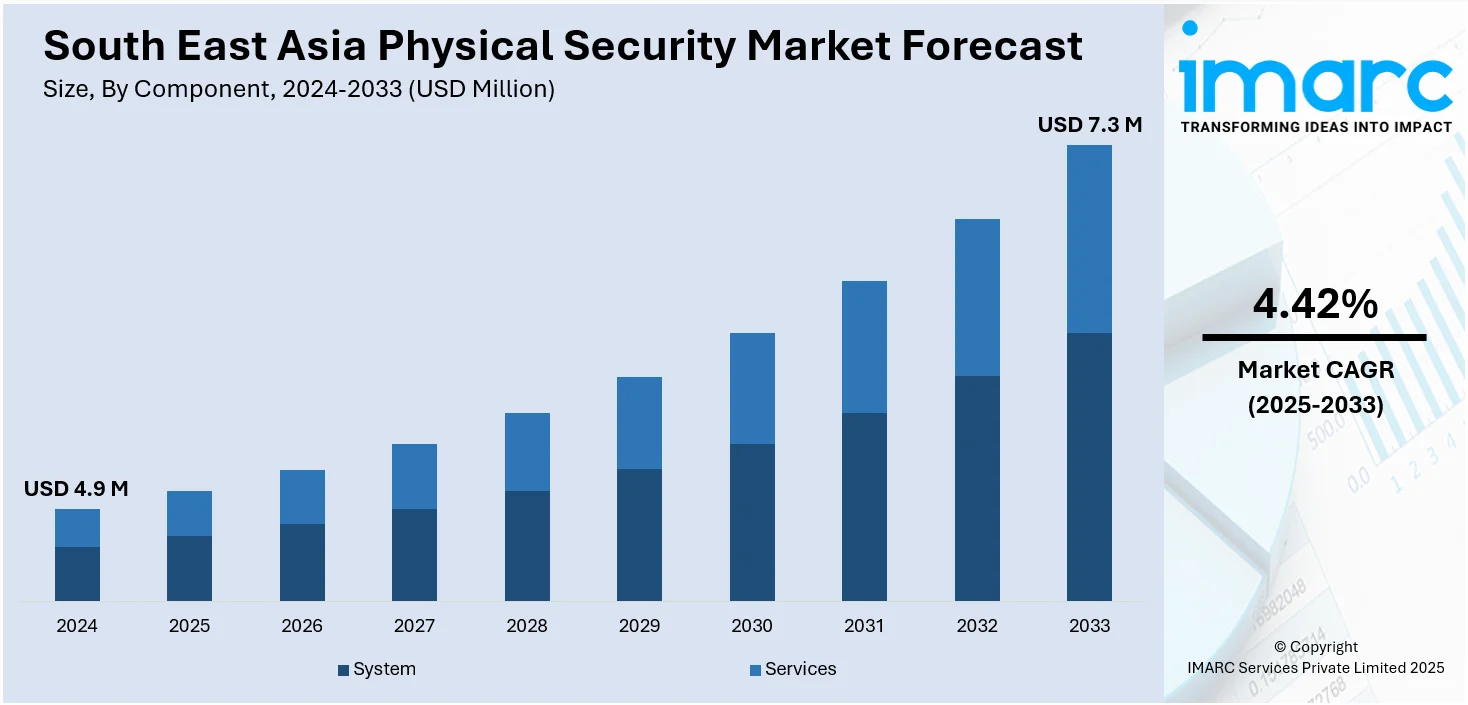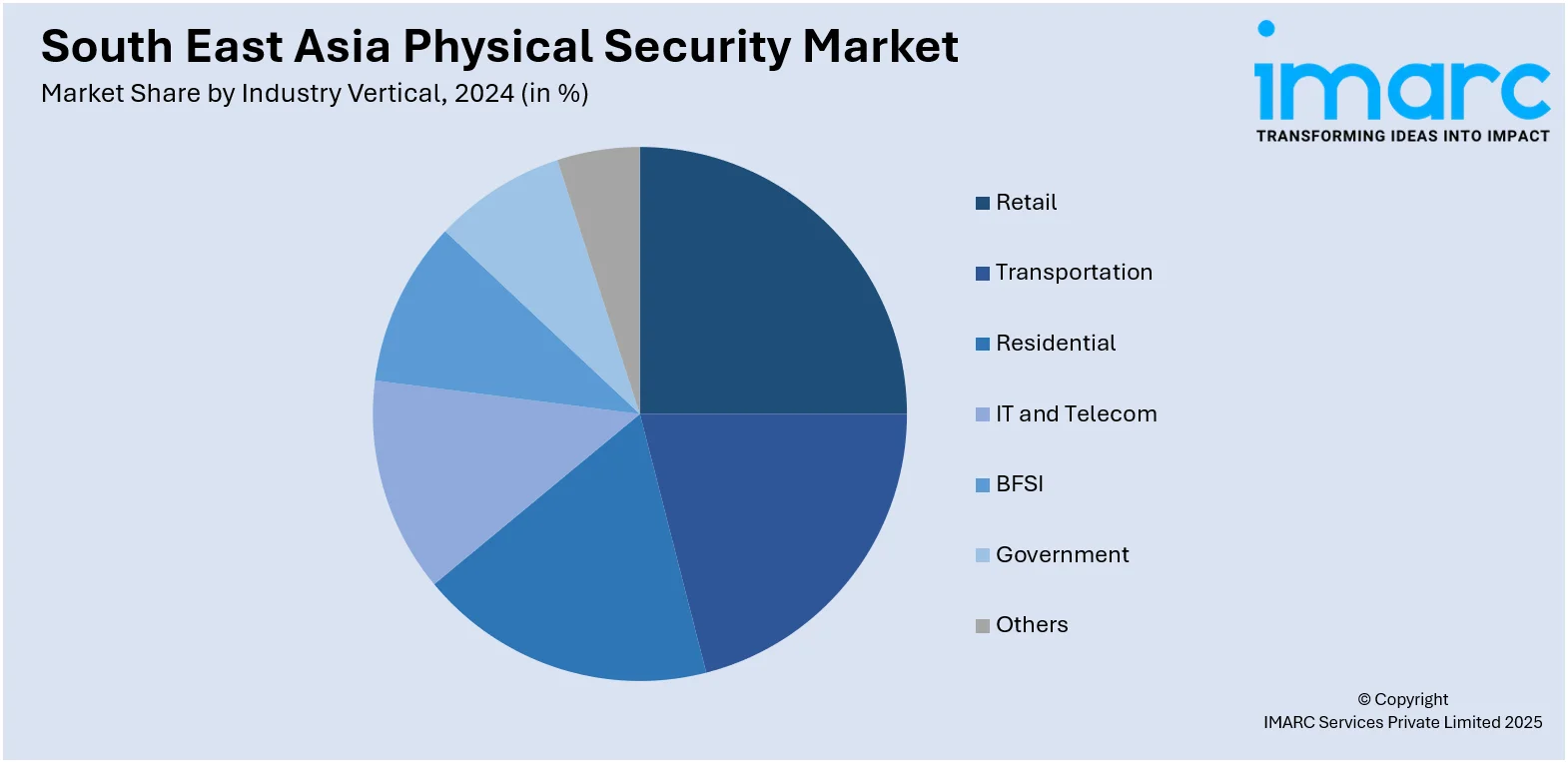
South East Asia Physical Security Market Size, Share, Trends and Forecast by Component, Enterprise Size, Industry Vertical, and Country, 2025-2033
Market Overview:
South East Asia physical security market size reached USD 4.9 Million in 2024. Looking forward, IMARC Group expects the market to reach USD 7.3 Million by 2033, exhibiting a growth rate (CAGR) of 4.42% during 2025-2033. The growing innovations in surveillance cameras, access control systems, and video analytics, rising security concerns, including terrorism, cyberattacks, theft, and vandalism, and increasing integration of cybersecurity measures represent some of the key factors driving the market.
|
Report Attribute
|
Key Statistics
|
|---|---|
|
Base Year
|
2024
|
|
Forecast Years
|
2025-2033
|
|
Historical Years
|
2019-2024
|
| Market Size in 2024 | USD 4.9 Million |
| Market Forecast in 2033 | USD 7.3 Million |
| Market Growth Rate 2025-2033 | 4.42% |
Physical security protects physical assets, facilities, and people from unauthorized access, theft, vandalism, or any potential harm. It protects the important resources of an organization, such as its human capital, by acting as the first line of defense against any external and internal threats. It encompasses several strategies and practices designed to ensure the safety and integrity of physical spaces. It relies on various security technologies and protocols, such as access control systems, surveillance cameras, perimeter fencing, alarm systems, and security personnel. It offers numerous advantages, including improving worker safety and maintaining legal compliance. It helps in safeguarding important assets and prevents financial loss. It is employed in various sectors, including commercial real estate, healthcare, educational institutions, and government facilities.

To get more information on this market, Request Sample
South East Asia Physical Security Market Trends:
At present, rising innovations in surveillance cameras, access control systems, and video analytics represent one of the crucial factors impelling the growth of the market in South East Asia. The advent of high-definition internet protocol (IP) cameras provides enhanced video quality and can be integrated into larger security ecosystems. This is driven by the growing need for real-time monitoring, analytics-driven insights, and remote access to security systems. Additionally, increasing preferences for unified security platforms by companies that combine various physical security components into a single, cohesive system to enhance efficiency, reduce operational costs, and improve incident response capabilities. The adoption of cloud-based solutions is gaining momentum, enabling remote monitoring and management from anywhere, at any time. Besides this, rising security concerns, including terrorism, cyberattacks, theft, and vandalism among governments, businesses, and individuals, are encouraging investments in security infrastructure, border control, and critical infrastructure protection. Moreover, the growing implementation of stringent regulations and standards to ensure public safety and protect critical infrastructure is driving the adoption of physical security solutions that meet the prescribed standards. The regulations related to critical infrastructure protection mandate stringent security measures for sectors, such as energy, transportation, and telecommunications. In addition, the increasing adoption of physical security solutions across various industry vertical, such as financial institutions for access control systems, surveillance, and biometric authentication to safeguard sensitive data and assets, is bolstering the market growth in the region. Furthermore, there is a rise in the integration of cybersecurity measures into physical security strategies for ensuring that surveillance cameras, access control systems, and other devices are protected against cyber threats. This is supporting the overall growth of the market in the region.
South East Asia Physical Security Market Segmentation:
IMARC Group provides an analysis of the key trends in each segment of the market, along with forecasts at the regional and country levels for 2025-2033. Our report has categorized the market based on component, enterprise size, and industry vertical.
Component Insights:
- System
- Physical Access System
- Video Surveillance System
- Perimeter Intrusion and Detection
- Physical Security Information Management
- Others
- Services
- System Integration
- Remote Monitoring
- Others
The report has provided a detailed breakup and analysis of the market based on the component. This includes system (physical access system, video surveillance system, perimeter intrusion and detection, physical security information management, and others) and services (system integration, remote monitoring, and others).
Enterprise Size Insights:
- Large Enterprises
- Small and Medium-sized Enterprises
A detailed breakup and analysis of the market based on the enterprise size have also been provided in the report. This includes large enterprises and small and medium-sized enterprises.
Industry Vertical Insights:

- Retail
- Transportation
- Residential
- IT and Telecom
- BFSI
- Government
- Others
The report has provided a detailed breakup and analysis of the market based on the industry vertical. This includes retail, transportation, residential, IT and telecom, BFSI, government, and others.
Country Insights:
- Indonesia
- Thailand
- Singapore
- Philippines
- Vietnam
- Malaysia
- Others
The report has also provided a comprehensive analysis of all the major regional markets, which include Indonesia, Thailand, Singapore, Philippines, Vietnam, Malaysia, and Others.
Competitive Landscape:
The market research report has also provided a comprehensive analysis of the competitive landscape. Competitive analysis such as market structure, key player positioning, top winning strategies, competitive dashboard, and company evaluation quadrant has been covered in the report. Also, detailed profiles of all major companies have been provided.
South East Asia Physical Security Market Report Coverage:
| Report Features | Details |
|---|---|
| Base Year of the Analysis | 2024 |
| Historical Period | 2019-2024 |
| Forecast Period | 2025-2033 |
| Units | Million USD |
| Scope of the Report | Exploration of Historical Trends and Market Outlook, Industry Catalysts and Challenges, Segment-Wise Historical and Future Market Assessment:
|
| Components Covered |
|
| Enterprise Sizes Covered | Large Enterprises, Small and Medium-sized Enterprises |
| Industry Verticals Covered | Retail, Transportation, Residential, IT and Telecom, BFSI, Government, Others |
| Countries Covered | Indonesia, Thailand, Singapore, Philippines, Vietnam, Malaysia, Others |
| Customization Scope | 10% Free Customization |
| Post-Sale Analyst Support | 10-12 Weeks |
| Delivery Format | PDF and Excel through Email (We can also provide the editable version of the report in PPT/Word format on special request) |
Key Questions Answered in This Report:
- How has the South East Asia physical security market performed so far and how will it perform in the coming years?
- What has been the impact of COVID-19 on the South East Asia physical security market?
- What is the breakup of the South East Asia physical security market on the basis of component?
- What is the breakup of the South East Asia physical security market on the basis of enterprise size?
- What is the breakup of the South East Asia physical security market on the basis of industry vertical?
- What are the various stages in the value chain of the South East Asia physical security market?
- What are the key driving factors and challenges in the South East Asia physical security?
- What is the structure of the South East Asia physical security market and who are the key players?
- What is the degree of competition in the South East Asia physical security market?
Key Benefits for Stakeholders:
- IMARC’s industry report offers a comprehensive quantitative analysis of various market segments, historical and current market trends, market forecasts, and dynamics of the South East Asia physical security market from 2019-2033.
- The research report provides the latest information on the market drivers, challenges, and opportunities in the South East Asia physical security market.
- Porter's five forces analysis assist stakeholders in assessing the impact of new entrants, competitive rivalry, supplier power, buyer power, and the threat of substitution. It helps stakeholders to analyze the level of competition within the South East Asia physical security industry and its attractiveness.
- Competitive landscape allows stakeholders to understand their competitive environment and provides an insight into the current positions of key players in the market.
Need more help?
- Speak to our experienced analysts for insights on the current market scenarios.
- Include additional segments and countries to customize the report as per your requirement.
- Gain an unparalleled competitive advantage in your domain by understanding how to utilize the report and positively impacting your operations and revenue.
- For further assistance, please connect with our analysts.
 Request Customization
Request Customization
 Speak to an Analyst
Speak to an Analyst
 Request Brochure
Request Brochure
 Inquire Before Buying
Inquire Before Buying




.webp)




.webp)












